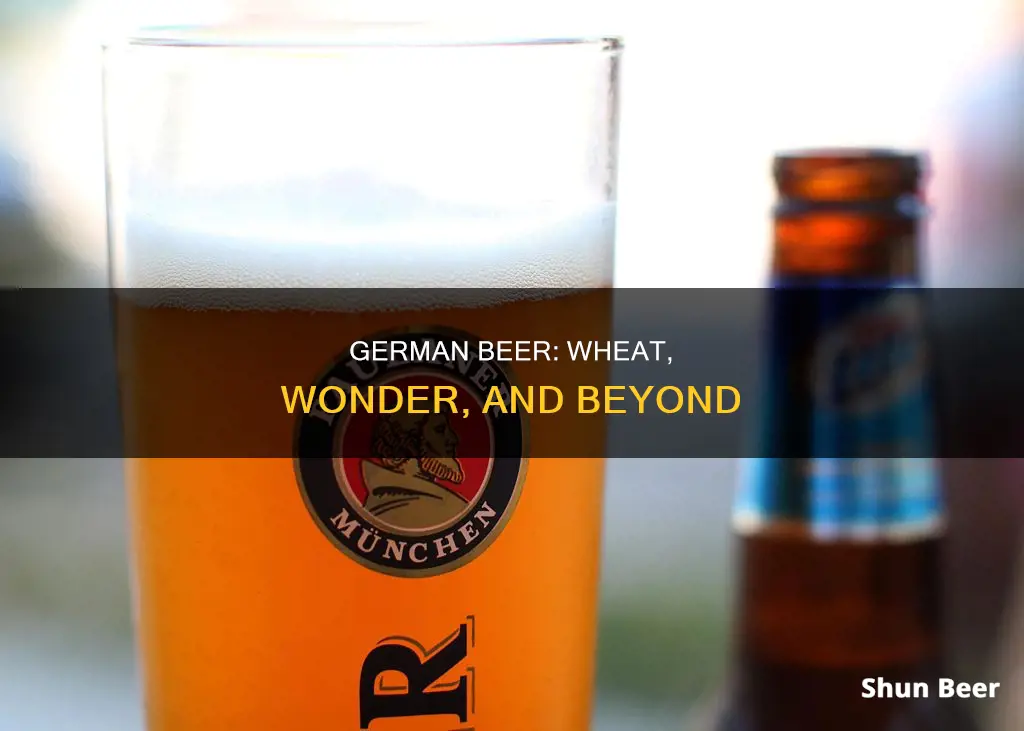
German beer is renowned worldwide, and one of its most recognisable styles is the German-style wheat beer, or hefeweizen. This type of beer is brewed with at least 50% malted wheat, yeast and other ingredients, resulting in a cloudy, golden colour and a thick foamy head. Hefeweizens are known for their distinctive banana, clove, bubblegum and even black pepper aromas and flavours. They are easy-drinking, refreshing beers that are perfect for any season. The history of hefeweizens dates back to the 1520s in Bavaria, Germany, and they have since become popular not only in Germany but also worldwide, including in America. Today, some of the most popular German hefeweizens are produced by breweries such as G. Schneider & Sohn and Weihenstephaner.
What You'll Learn
- German Weizenbier is a wheat beer, top-fermented and brewed with a large proportion of wheat
- German Weizenbier is also known as Hefeweizen, which refers to the yeast remaining in suspension
- Hefeweizen typically contains a low to moderate alcohol content and is considered the most popular German Weizenbier variety
- Bavarian wheat beer tradition has a history dating back hundreds of years, but brewing wheat beer was once reserved for Bavarian royalty
- German wheat beers are known for their distinctive banana and clove yeast character

German Weizenbier is a wheat beer, top-fermented and brewed with a large proportion of wheat
Wheat beer is a top-fermented beer brewed with a large proportion of wheat relative to the amount of malted barley. German Weizenbier is a wheat beer, top-fermented and brewed with a large proportion of wheat. It is also known as Hefeweizen, and is one of the two main varieties of wheat beer, the other being Belgian Witbier.
German Weizenbier is traditionally from Bavaria, where it was introduced in the 15th century from neighbouring Bohemia. By law, Weizenbiers brewed in Germany must be top-fermented. They are brewed with at least 50% malted wheat, although some versions use up to 70%. The remainder is typically Pilsner malt. The wheat impairs clarity in an unfiltered beer, giving it a cloudy appearance.
The aroma and flavour of a Weizenbier come largely from the yeast and are decidedly fruity (banana) and phenolic (clove). The intensity of these flavour qualities varies depending on the brewer, but the two are most commonly balanced. Weizenbier typically contains a low to moderate alcohol content.
The four largest brands of Weizenbier in Germany are Erdinger, Paulaner, Franziskaner, and Maisel. Other renowned brands are Augustiner, Weihenstephaner, Schneider, and Andechser.
Belgian Beers: Wheat-Based Brews or Not?
You may want to see also

German Weizenbier is also known as Hefeweizen, which refers to the yeast remaining in suspension
German Weizenbier, also known as Hefeweizen, is a wheat beer that originated in the Bavarian breweries of southern Germany in the 16th century. The name "Hefeweizen" refers to the yeast remaining in suspension, which gives the beer its cloudy appearance. In German, "hefe" means yeast, and "weizen" means wheat.
Hefeweizen is characterised by its use of wheat malt, unique yeast, and uncharacteristic appearance. It is straw to amber in colour and brewed with at least 50% malted wheat. The aroma and flavour of Hefeweizen come largely from the yeast and are typically fruity (banana) and phenolic (clove). The intensity of these flavour qualities varies depending on the brewer, but they are most commonly balanced.
Hefeweizen is highly carbonated, with relatively low hop bitterness, and has low to moderate alcohol content. It is best served in a large, curvaceous glass, known as a weizen vase, which showcases the beer's beautiful glow and foam cap.
Hefeweizen is considered one of the most recognisable and enjoyable beer styles in the world, offering a striking beer experience. It pairs well with a variety of lighter foods, such as salads, seafood, and egg dishes.
Dating Boulevard Wheat Beer: A Beginner's Guide
You may want to see also

Hefeweizen typically contains a low to moderate alcohol content and is considered the most popular German Weizenbier variety
Hefeweizen is a popular German wheat beer, or Weizenbier, that typically contains a low to moderate alcohol content. It is one of the most well-known and recognisable beer styles in the world, and is considered the most popular German Weizenbier variety.
Hefeweizen is a Bavarian wheat beer that originated in Germany and is characterised by its use of wheat malt, yeast, and unfiltered, cloudy appearance. The name "Hefeweizen" comes from the German words "hefe", meaning yeast, and "weizen", meaning wheat. This wheat beer is brewed with at least 50% malted wheat, and sometimes the percentage of wheat is even higher, reaching up to 70% wheat to barley. The yeast remains in suspension, giving Hefeweizen its distinctive cloudy look and leaving yeast in the empty glass.
The aroma and flavour of Hefeweizen come largely from the yeast and are typically fruity, with notes of banana, and phenolic, with a clove-like taste. Some Hefeweizens may also have undertones of bubble gum or vanilla. The sweetness of the beer comes from the wheat, and it is known for its high carbonation and crisp, drinkable quality.
Hefeweizen is best served cold, around 45 degrees Fahrenheit, in a specific style of glass called a Weizen vase or Weizenbier glass. This glass is tall and curvaceous, showcasing the beer's glow and foam cap. It is said to taste best when freshly poured at a brewery.
Berliner Weisse Beer: Wheat or Not Wheat?
You may want to see also

Bavarian wheat beer tradition has a history dating back hundreds of years, but brewing wheat beer was once reserved for Bavarian royalty
Bavarian wheat beer, or weissbier, has a long and interesting history. The first true weissbier brewery was built in the 15th century in the Bavarian village of Schwarzach by the noble Degenberger family. Although the Reinheitsgebot purity law of 1516 prohibited the use of wheat malt, the Degenbergers were exempt due to their grandfathered tenure in the brewing industry. Weissebier was also the preferred beer of the Bavarian royalty.
When the last of the Degenbergers died, control of the brewery passed to the ruling Bavarian dukes, the Wittelsbachs, who were the authors of the Reinheitsgebot law. The Wittelsbachs became the sole producers of wheat beer in Bavaria and expanded their domain by building more weissbier breweries in southern Germany. They required the pubs they controlled to serve their brown beer (dunkels) as well as weissbier, and the beer became so popular that a road, known as the Bierstrasse (beer street), was built from a ducal brewery in Kelheim to Ingolstadt to quench the thirst of university students.
In the 19th century, the development of better malting techniques, lager-brewing refinement, and microbiological advances revolutionized the brewing world. Munich breweries tweaked their dunkels, and Bohemia and Vienna perfected their pale lagers. As a result, pilsners and pale lagers replaced weissebiers as the everyday drink among the masses, and wheat beer consumption declined drastically.
However, wheat beers were revived thanks to the efforts of Georg Schneider, who became the tenant of the ducal brewery in Kelheim in 1855. Schneider began producing his own wheat beers and ended the royal control of wheat beer production in 1872. Through aggressive production, he brought wheat beers back into the mainstream, and they enjoyed a comeback.
Today, wheat beers are once again an integral part of Bavarian culture, often enjoyed during the mid-morning break known as brotzeit. They come in various forms, including weissbier, weizenbier, kristall, and dunkelweizen, and make up a significant portion of the German beer market.
Wheat Allergy and Beer: Is It Safe to Drink?
You may want to see also

German wheat beers are known for their distinctive banana and clove yeast character
The German-style hefeweizen is a classic example of a German wheat beer with a prominent banana and clove character. It is straw to amber in colour, with a cloudy appearance due to the suspended yeast. The aroma and flavour of hefeweizen are fruity, with notes of banana, and phenolic, with hints of clove. The intensity of these flavours can vary depending on the brewer, but they are usually well-balanced. Hefeweizen is typically low to moderately strong in alcohol content, making it a refreshing and approachable beer.
The distinctive banana and clove notes in German wheat beers are also influenced by the type of yeast used during fermentation. The yeast strain commonly used in wheat beers, such as the W68 strain, produces a balanced profile of 4-vinyl guaiacol and isoamyl acetate. However, other strains like the W175 can lead to higher concentrations of these compounds, resulting in a more intense banana and clove character. Brewers need to carefully control the fermentation process to avoid overwhelming these flavours.
The proper fermentation temperature is crucial in achieving the desired banana and clove character in German wheat beers. A temperature of around 62 °F (17 °C) is recommended to attain the best results. While higher fermentation temperatures can increase the production of esters, they can also lead to higher levels of fusel alcohols and other by-products, affecting the overall sensory outcome. Brewers may experiment with different pitching rates and oxygen levels to fine-tune the fermentation character.
German wheat beers, especially hefeweizen, have gained popularity for their unique flavour profile and refreshing qualities. The combination of fruity banana and spicy clove notes makes these beers versatile food pairings, complementing a variety of dishes such as salads, seafood, and egg dishes. The complexity and balance of flavours in German wheat beers showcase the art of brewing, making them a favourite among beer enthusiasts and newcomers alike.
Rye Beer and Wheat: What's the Connection?
You may want to see also
Frequently asked questions
German wheat beer, or Weizenbier, is a top-fermented beer brewed with at least 50% malted wheat. It is characterised by its cloudy appearance, high carbonation, and fruity and spicy flavours, particularly banana and clove.
The two main varieties of German wheat beer are Weizenbier and Belgian Witbier. Other types include Berliner Weisse, a cloudy and sour beer, and Gose, a sour and salty beer.
Popular German wheat beer brands include Erdinger, Paulaner, Franziskaner, and Maisel. Other well-known brands are Augustiner, Weihenstephaner, Schneider, and Andechser.







